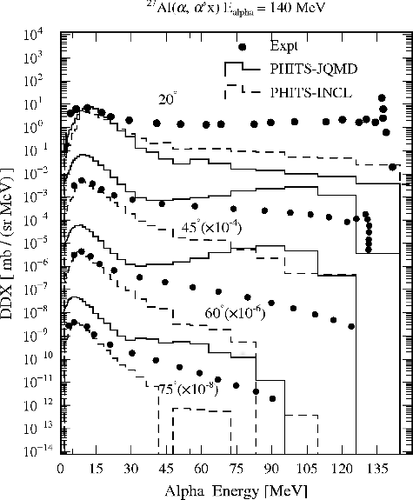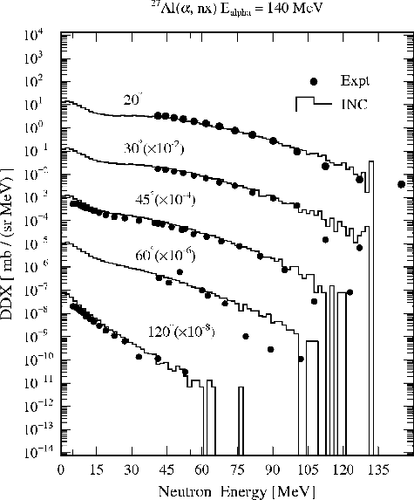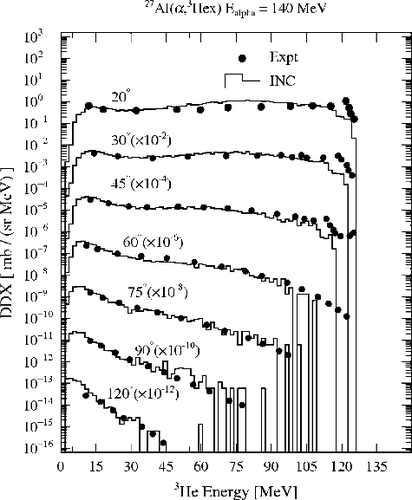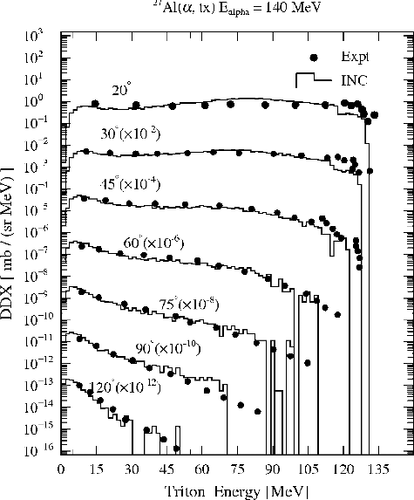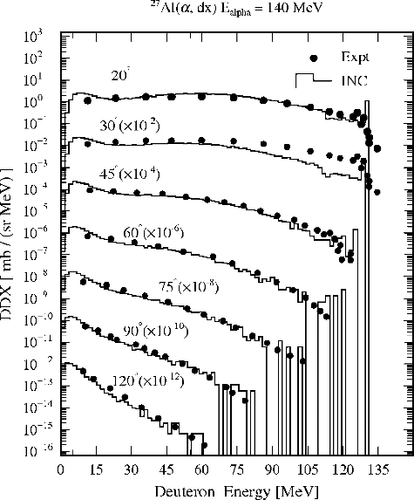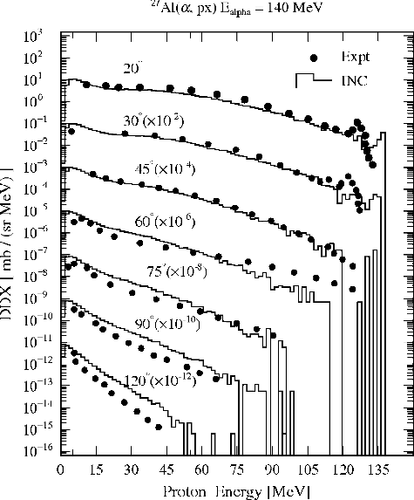Figures & data
Figure 1. INCL (dashed lines) and JQMD (solid lines) model calculations for deuteron bombardment of an 27Al target at 80 MeV in comparison with experimental values (dots) taken from [Citation18 ]. For visualization purposes, each data-set has been multiplied by the factor shown in brackets.
![Figure 1. INCL (dashed lines) and JQMD (solid lines) model calculations for deuteron bombardment of an 27Al target at 80 MeV in comparison with experimental values (dots) taken from [Citation18 ]. For visualization purposes, each data-set has been multiplied by the factor shown in brackets.](/cms/asset/a96308c3-62d3-4423-80ad-e8e01e09b967/tnst_a_1389313_f0001_b.gif)
Table 1. Values of c coefficients in EquationEquations (3)(3)
(3) and (Equation4
(4)
(4) )
Figure 3. Comparison of the calculation results for proton-production DDXs from 80-MeV deuterons bombarding 27Al at angles of 30°, 45°, and 60° for different values of the deuteron potential depth. The solid circles show the experimental data taken from EXFOR [Citation20]. The dotted, dashed, and line histograms are the INC calculation results for d potential depths of 10, 20, and 15 MeV, respectively. For visualization, the DDXs have been multiplied by the factors indicated.
![Figure 3. Comparison of the calculation results for proton-production DDXs from 80-MeV deuterons bombarding 27Al at angles of 30°, 45°, and 60° for different values of the deuteron potential depth. The solid circles show the experimental data taken from EXFOR [Citation20]. The dotted, dashed, and line histograms are the INC calculation results for d potential depths of 10, 20, and 15 MeV, respectively. For visualization, the DDXs have been multiplied by the factors indicated.](/cms/asset/5ba3530c-218b-4aee-bab1-7be7887f5178/tnst_a_1389313_f0003_b.gif)
Figure 4. Comparison of the calculation results for proton-production DDXs from 140-MeV alpha particles bombarding 27Al at angles of 20°, 30°, and 45° for different values of the potential depth for the incident alpha particle. The solid circles show the experimental data taken from EXFOR [Citation20]. The dash-dotted, solid, and dotted line histograms are the INC calculation results for alpha-particle potential depths of 30, 40, and 60 MeV, respectively. For visualization, the DDXs have been multiplied by the factors indicated.
![Figure 4. Comparison of the calculation results for proton-production DDXs from 140-MeV alpha particles bombarding 27Al at angles of 20°, 30°, and 45° for different values of the potential depth for the incident alpha particle. The solid circles show the experimental data taken from EXFOR [Citation20]. The dash-dotted, solid, and dotted line histograms are the INC calculation results for alpha-particle potential depths of 30, 40, and 60 MeV, respectively. For visualization, the DDXs have been multiplied by the factors indicated.](/cms/asset/5c286cb8-9ae5-41a8-bc37-5b9f4acf69e8/tnst_a_1389313_f0004_b.gif)
Figure 5. INC model calculations coupled with GEM for 27Al(d, d'x) reaction at 80 MeV at angles of 30°–150°. The solid circles show the experimental data taken from EXFOR [Citation20] and the dots are the experimental data taken from [Citation18 ]. For visualization, the DDXs have been multiplied by the factors indicated.
![Figure 5. INC model calculations coupled with GEM for 27Al(d, d'x) reaction at 80 MeV at angles of 30°–150°. The solid circles show the experimental data taken from EXFOR [Citation20] and the dots are the experimental data taken from [Citation18 ]. For visualization, the DDXs have been multiplied by the factors indicated.](/cms/asset/0e3c6862-8f58-4f8b-bcf6-354fb957fbd4/tnst_a_1389313_f0005_b.gif)
Figure 6. Same as , but for 27Al(d, px) reaction at 80 MeV. The solid circles are the experimental data taken from EXFOR [Citation20].
![Figure 6. Same as Figure 5, but for 27Al(d, px) reaction at 80 MeV. The solid circles are the experimental data taken from EXFOR [Citation20].](/cms/asset/969d0e95-5fa3-4417-869f-3bc974bc5744/tnst_a_1389313_f0006_b.gif)
Figure 7. Same as , but for 27Al(d, px) reaction at 99.6 MeV. The solid circles are the experimental data taken from EXFOR [Citation20].
![Figure 7. Same as Figure 5, but for 27Al(d, px) reaction at 99.6 MeV. The solid circles are the experimental data taken from EXFOR [Citation20].](/cms/asset/6be21316-8607-4901-8e15-8bfd9385cf25/tnst_a_1389313_f0007_b.gif)

